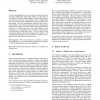Free Online Productivity Tools
i2Speak
i2Symbol
i2OCR
iTex2Img
iWeb2Print
iWeb2Shot
i2Type
iPdf2Split
iPdf2Merge
i2Bopomofo
i2Arabic
i2Style
i2Image
i2PDF
iLatex2Rtf
Sci2ools
AFRIGRAPH
2004
ACM
2004
ACM
Impact of large displays on virtual reality task performance
A better understanding of how users perform virtual reality tasks may help to build better virtual reality interfaces. In this study, we concentrate on the impact of large displays in virtual reality depending on the tasks and users’ characteristics. The two virtual reality tasks studied are the objects manipulation and the navigation in an environment. The users’ characteristics studied are the visual attention abilities. Forty subjects participated in the experimentation composed of cognitive tests used to evaluate visual attentional abilities and a set of virtual reality tasks. Our study exhibits two main conclusions. (i) Large displays positively impact on performances for some kinds of virtual reality tasks. (ii) Users with low level of attentional abilities take more advantage of large displays. We conclude that large displays can be considered as cognitive aids depending on the tasks and users’ characteristics. CR Categories: H.5.2 [User interfaces]: ergonomics—, evalua...
| Added | 30 Jun 2010 |
| Updated | 30 Jun 2010 |
| Type | Conference |
| Year | 2004 |
| Where | AFRIGRAPH |
| Authors | Florence Tyndiuk, V. Lespinet-Najib, Gwenola Thomas, Christophe Schlick |
Comments (0)

